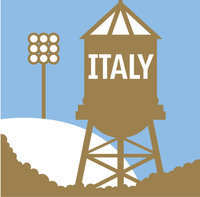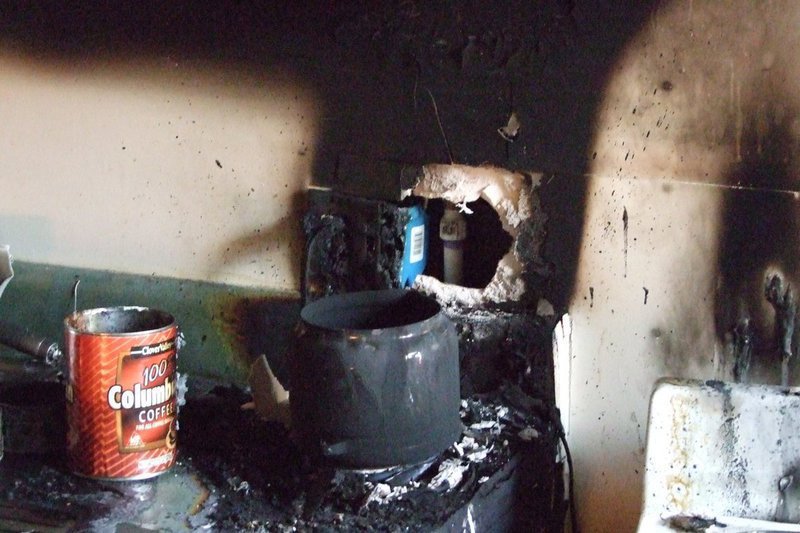Only the kitchen was burned by fire
Fire damaged the kitchen — The kitchen fire did not damage the building, on Morgan Road. Construction materials used in the dome home make it fire resistant. (Anne Sutherland)
Thursday evening was quiet until the fire department and sheriff’s department was called to the domes on Morgan Road. Dome renter, Jimmy Watt, was coming home from work when he heard an alarm from inside his home. He opened the door to see things in the kitchen melted, cabinets burned and soot on everything from a fire that had extinguished itself. “I thought my radio alarm was beeping when I walked up to my door,” Watt said, “but it was the smoke alarm.”
“When I walked in I saw that it had been a fire.” Italy Fireman, Brad Chambers, said, “I believe it was the coffee pot. It was either left turned on or shorted out.”
The part that is so interesting about this story is that the fire extinguished itself. The sheetrock was damaged and so was the countertop and stove. The rest of the building did not burn. The Monolithic Dome is built out of shotcrete — an air entrained concrete that makes the building very strong and cannot burn. Owner, David South, said, “Contents of a dome will burn but the building will not.”
According to Monolithic’s website, Monolithic Domes are built to high standards. The article entitled “The True Cost of a Dome” by David South, Jr. states: “All standard US homes are built as Type V fire rated structures. Which means they are built entirely of combustible materials. One match and it’s gone. A dome is fire rated at Type II or better. It just doesn’t burn. The contents inside may, but the overall fire safety is incredibly high. This can save money in the long term by lowering the homeowners insurance policy.” Monolithic recommends renters insurance when living in a dome.
According to Dr. Arnold Wilson, retired Civil Engineer Professor from Brigham Young University, said, “Buildings should be capable of providing safety from the elements without excessive costs. If you live in a conventional wood framed house, with sheet rock on the inside, 1/2” plywood on the outside of wood studs and siding or plaster on the outside, you live in a building that will protect you from some wind, rain, snow and sun. But heat and air conditioning costing twice as much as energy used by most concrete dome homes are common. And an inside fire will penetrate the 1/2" sheet rock in about 20 minutes. A recent example of a two-story frame house as described above had a fire from a wood-burning stove, in the middle of the night, and its occupants literally ran for their lives. The fire department was at the house in less than 20 minutes to put out the fire that caused extensive damage to the interior. House and contents would have been completely destroyed in another 20 minutes.
“Many people don’t realize how fast fire works. Several years back in Georgia, four units of an apartment complex and some 25 automobiles in a nearby parking lot disappeared in just a few minutes. Someone accidentally tipped over a red hot barbecue. Fire spread over the grass and within seconds attacked the vinyl siding that covered the buildings. Five fire fighting units arrived within seven minutes, but they could not save the four structures or the cars. Radiant heat from the burning buildings even melted the vinyl siding on two buildings 80 feet away. A fire chief later said that had the fire fighters been sitting on the spot, they could not have stopped the fire. If a fire attacked the outside of a Monolithic Dome, it might melt the foam, but the concrete would still be there. Concrete dome buildings succeed in providing safety to their occupants better than most other buildings.”
To help prevent fires, keep a fire extinguisher handy. However, experts say check the expiration date because they all expire. Also, learn how to operate one. That will be the challenge of the day but the instructions are clear on the tank. Make sure your kids know about different fires, i.e, grease or electrical. Remember, to never throw water on a grease fire. It should be smothered with a towel or throw salt on it. Water will spread the fire and burn you. Also, if it is electrical, cut the power. Call emergency services from a neighbor’s house. You could be overcome by smoke. Don’t let the kids use the stove unsupervised. Accidents do happen and it is better to stick with the microwave or takeout when you are not home.
No one was hurt in this local fire. It’s important and good to know there are buildings that are completely safe. People that are informed can be safer as well.

